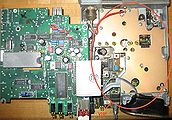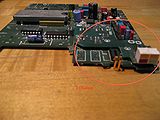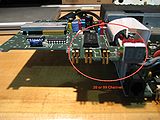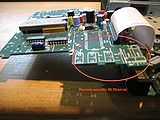Difference between revisions of "EF Johnson Challenger Series Information"
RadioNerds (talk | contribs) |
RadioNerds (talk | contribs) |
||
| Line 262: | Line 262: | ||
| − | [[Category: | + | [[Category:EF Johnson]] |
Latest revision as of 12:32, 22 May 2013
Contents
EF Johnson Series Radio Information
these are very versatile radios, they will easily move into the ham bands VHF and UHF models. The logic boards can be swapped between models and reprogrammed so that you can make a 2 Channel VHF a 99 channel by just replacing the logic board and reprogramming. The boards between UHF and VHF are fully interchangeable. I have also converted non-remote models to remote and vice versa. Converting Dash Mount EF Johnson Challenger Radios to Remote Mount
Model Number Decoding
Challenger series radios have the following part numbers. They are in the form:
- 242-MMMM-TBA
- 242 = For the Challenger Series line
- MMMM = Model Number (see below)
- T = Radio Type
- B = Frequency Band
- A = Accessories / Programming
Models
The VHF units were 715x and 716x (the 5x were 1st generation and 6x were 2nd generation)
The UHF units were 717x and 718x (the 7x were 1st generation and 8x were 2nd generation)
The following numbers replace the x as mentioned above:
- 71x1
- 2 Channel
- 25 watts (VHF)
- 15 watts (UHF)
- 71x2
- 8 Channel
- 25 watts (VHF)
- 15 watts (UHF)
- 71x3
- 2 Channel
- 40 watts (VHF)
- 35 watts (UHF)
- 71x4
- 8 Channel
- 40 watts (VHF)
- 35 watts (UHF)
- 71x5
- 20 Channel
- 40 watts (VHF)
- 35 watts (UHF)
- 71x6
- 99 Channel
- 40 watts (VHF)
- 35 watts (UHF)
- 71x7
- 99 Channel
- 100 watts (VHF)
- 80 watts (UHF)
If it had a -5 after the number it was a remote mount system
- 7151
- Band: VHF
- Channels: 2 Channel
- Output: 25 Watts
- 7152
- Band: VHF
- Channels: 8 Channel
- Output: 25 Watts
- 7153
- Band: VHF
- Channels: 2 Channel
- Output: 40 Watts
- 7154
- Band: VHF
- Channels: 8 Channel
- Output: 40 Watts
- 7155
- Band: VHF
- Channels: 20 Channel
- Output: 40 Watts
- 7156
- Band: VHF
- Channels: 99 Channel
- Output: 40 Watts
- 7157
- Band: VHF
- Channels: 99 Channel
- Output: 100 Watts
- 7161
- Band: VHF
- Channels: 2 Channel
- Output: 25 Watts
- 7162
- Band: VHF
- Channels: 8 Channel
- Output: 25 Watts
- 7163
- Band: VHF
- Channels: 2 Channel
- Output: 40 Watts
- 7164
- Band: VHF
- Channels: 8 Channel
- Output: 40 Watts
- 7165
- Band: VHF
- Channels: 20 Channel
- Output: 40 Watts
- 7166
- Band: VHF
- Channels: 99 Channel
- Output: 40 Watts
- 7167
- Band: VHF
- Channels: 99 Channel
- Output: 100 Watts
- 7171
- Band: UHF
- Channels: 2 Channel
- Output: 15 Watts
- 7172
- Band: UHF
- Channels: 8 Channel
- Output: 15 Watts
- 7173
- Band: UHF
- Channels: 2 Channel
- Output: 35 Watts
- 7174
- Band: UHF
- Channels: 8 Channel
- Output: 35 Watts
- 7175
- Band: UHF
- Channels: 20 Channel
- Output: 35 Watts
- 7176
- Band: UHF
- Channels: 99 Channel
- Output: 35 Watts
- 7177
- Band: UHF
- Channels: 99 Channel
- Output: 80 Watts
- 7181
- Band: UHF
- Channels: 2 Channel
- Output: 15 Watts
- 7182
- Band: UHF
- Channels: 8 Channel
- Output: 15 Watts
- 7183
- Band: UHF
- Channels: 2 Channel
- Output: 35 Watts
- 7184
- Band: UHF
- Channels: 8 Channel
- Output: 35 Watts
- 7185
- Band: UHF
- Channels: 20 Channel
- Output: 35 Watts
- 7186
- Band: UHF
- Channels: 99 Channel
- Output: 35 Watts
- 7187
- Band: UHF
- Channels: 99 Channel
- Output: 80 Watts
Radio Type
- 0 = Standard Front Mount
- 1 = Standard Remote Mount
Frequency Band
- 1 = 403 - 430 mHz
- 2 = 450 - 488 mHz
- 3 = 488 - 512 mHz
Accessories / Programming
- 0-9 = Additional accessories
Radio Identification by Images
you can easily identify the band of the radio by looking at the inside. the UHF has two small cover plates the the VHF has on large one.
Power output of the radio can be determined by the size of the rear heatsink. the max power is also determined by the band (UHF/VHF)
Determining the number of Channels
(I'm missing an 8 channel image, but its easy, it only has one digit)







